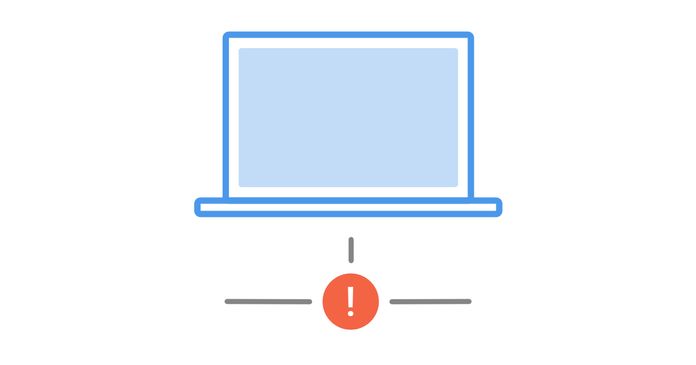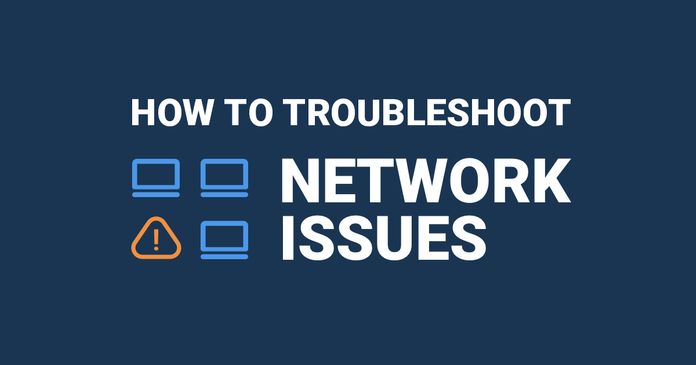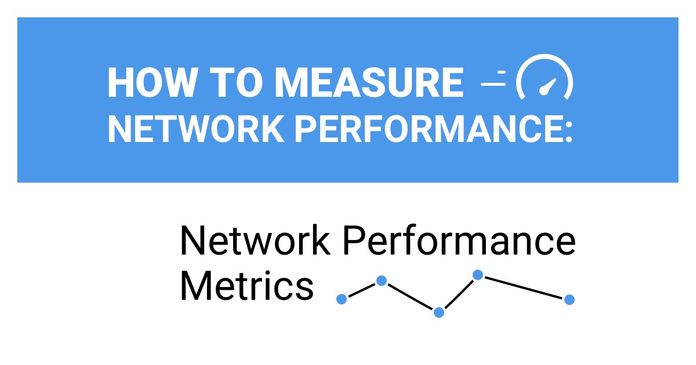Table of Contents
Table of Contents
Have you ever been in the middle of an important video call, only for it to glitch or freeze out of nowhere? Or did an application suddenly slow down right when you needed it most? These frustrating moments can often be caused by something hidden in the background: packet bursts.
But what exactly are packet bursts, and why do these sudden surges in data traffic catch you off guard when your network seems steady? Are they just random spikes in the data flow, or is there something deeper causing them? And more importantly, is there a way to catch them before they disrupt your network?
In this article, we’ll dig into these questions and show you how to take control of packet bursts once and for all, so they don’t interrupt your workflow or impact your end users. Spoiler alert: the right monitoring tool makes all the difference!
A packet burst is a sudden, intense spike in data transmission, where a large number of packets flow through the network over a brief period, creating a concentrated surge in network traffic. Unlike regular, balanced network traffic where packets flow in a consistent, controlled flow, packet bursts exceed the network's capacity to handle data smoothly.
This often overwhelms network devices like routers and switches, which have a finite capacity to process and forward packets. When the volume of packets exceeds this capacity, network performance issues, such as latency (delay), jitter (variations in delay), and packet loss, can occur.


1. High Density
Bursts contain packets that are "back-to-back" with minimal delay between them. This high density is particularly challenging for network devices like routers and switches, which are designed to handle steady, manageable traffic flows. When multiple packets arrive in quick succession, devices must process each packet at once, which can quickly fill buffers, congest the network, and lead to packet loss if the data flow exceeds device capacity.
2. Short Duration
Packet bursts are typically short-lived events that last only a few milliseconds or seconds, but they can create significant disruptions during that time. Unlike sustained high traffic (such as large file downloads or streaming), which may be handled by expanding bandwidth or adjusting traffic priorities, the intensity of a burst in a short window often overwhelms a network before these adjustments can occur. The short timeframe of these bursts makes them particularly tricky to spot without the right monitoring tools, leading to network congestion, high latency, and packet drops.
3. Unpredictable
The intermittent and unpredictable nature of packet bursts is one of their most challenging aspects. They can occur sporadically due to various factors – application behaviours, sudden user actions, or device responses to network congestion. Unlike regular network traffic, which is easier to predict and plan for, bursts are often irregular, making it hard to set up fixed strategies for handling them. This unpredictability requires proactive network monitoring and dynamic traffic control measures like Quality of Service (QoS) and traffic shaping, which can help manage bursts by prioritizing critical traffic during sudden load spikes.
Packet bursts are a well-known challenge in online gaming, where large amounts of data flow continuously due to multiplayer interactions, voice communication, and live updates. Similarly, in enterprise environments, packet bursts are extremely common, especially in large-scale networks with numerous users and devices transmitting data simultaneously. Both scenarios demand proactive monitoring and troubleshooting to prevent disruptions.
This article provides insights to help you tackle packet bursts effectively, whether you’re aiming for a seamless gaming experience or ensuring smooth business operations.
Understanding the causes of packet bursts is essential for effectively managing and troubleshooting them, as they can originate from various sources within a network and are usually a symptom of another network issue. These causes range from network congestion and device buffering to the behaviour of applications and routing protocols.
Let’s explore some common sources of packet bursts:
- Sudden Demand Surges: Packet bursts often occur during unexpected traffic surges when multiple devices or users simultaneously initiate high-bandwidth activities. For example, in an office setting, if several employees start video conferencing sessions at once, the network can experience a spike in traffic, potentially resulting in packet bursts.
- Limited Bandwidth Resources: If network bandwidth is insufficient to handle such surges, packets can build up and transmit in bursts as the network struggles to process them. This scenario often occurs in shared network environments or areas with limited resources, causing congestion as data demands exceed the network’s capacity.
Avoid the network traffic jam! Learn what network congestion is, what causes it, and most importantly, how to fix it using Network Monitoring tools.
Learn more

- Buffer Overflow: Most network devices (like routers and switches) come equipped with buffers to temporarily hold packets in transit. When too many packets arrive at once, these buffers can fill quickly. Once the buffer has space, it releases packets in a burst, leading to a temporary spike in traffic. For instance, a router processing a high volume of packets from multiple sources might hold some packets in its buffer until bandwidth becomes available.
- Queuing Mechanisms: Network devices often use queuing techniques to organize packets. If the queue reaches its limit due to high demand, it may release packets in batches, creating a burst effect. Devices with smaller buffer capacities are especially prone to such queuing bursts during peak traffic periods.

- Large Data Transfers: Certain applications, especially those involving large data transfers, can cause bursts by sending data in bulk. For example, applications such as data backup services, file-sharing platforms, and video streaming services often transmit high data volumes quickly, generating a dense packet flow in a short timeframe.
- Batch Processing in Enterprise Applications: Business applications like ERP systems or CRM databases sometimes process data in batches. This means large amounts of data are transmitted all at once, particularly during scheduled updates or backups. Such events can cause packet bursts, impacting other users sharing the same network resources.
- Behaviour of Real-Time Applications: Real-time applications, including online gaming and video conferencing tools, tend to send data in short, rapid bursts to minimize latency. When multiple users engage in these applications simultaneously, the aggregated traffic from all these bursts can create a larger burst effect across the network.
- TCP/IP Retransmissions: TCP (Transmission Control Protocol) retransmits lost packets to ensure reliable data delivery. In cases of packet loss or delays, TCP may retransmit packets, resulting in sudden bursts of traffic as these retransmitted packets re-enter the network. This can lead to additional packet congestion and even more retransmissions if the network is already overloaded.
- Routing Convergence: Routing protocols can sometimes contribute to bursts during convergence. For example, when a network device or route fails, routing protocols adjust the network paths to maintain connectivity. This process, known as convergence, can temporarily increase packet transmission rates as data re-routes, generating a brief burst effect.
- Protocol-Specific Behaviors: Certain network protocols handle data differently, sometimes in ways that can lead to bursts. For instance, UDP (User Datagram Protocol), which is commonly used in video streaming and VoIP, doesn’t establish a connection before transmitting data and may transmit large amounts of data quickly without flow control, leading to bursty traffic.
Packet bursts often result from a combination of these factors, making them challenging to predict and control. In business settings, especially those with high demands on data integrity and reliability, such as finance, healthcare, or e-commerce, understanding and managing these causes is essential to maintain smooth network performance.
Packet bursts can severely impact network performance. To make things worse, often you can't even see a packet burst happening, but you can identify the symptoms. That being said, there are tools that can help you spot them as they're happening. Here’s how to recognize packet bursts by monitoring key metrics, spotting common signs, and using effective detection tools.
When packet bursts happen, they will affect a variety of other metrics in your network related to data transmission. So while "packet bursts" are not a metric in themselves, you can monitor other network metrics to identify if packet bursts are happening:
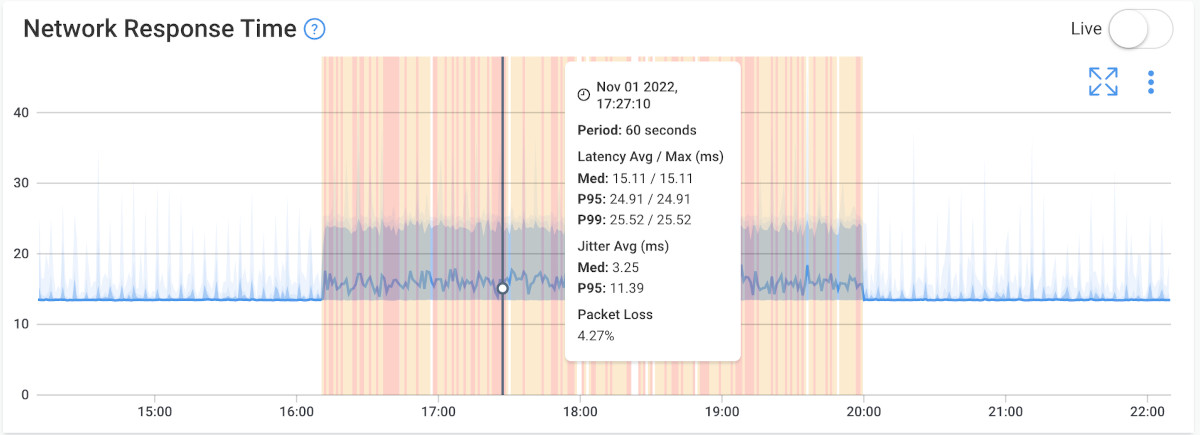
- Throughput: A sudden increase in throughput often indicates a packet burst, as more data is transmitted than usual within a short period.
- Latency Spikes: Packet bursts frequently cause latency spikes, as network devices struggle to process the increased data volume.
- Packet Loss: High packet loss can signal that packets are arriving faster than they can be processed, leading to discarded data.
- Buffer Usage and Queue Lengths: Observing high buffer utilization or long queue lengths in networking devices is a strong indicator of packet bursts.
As we said earlier, you can’t see packet bursts happening, but you can feel their impact on your network. Here are red flags to look out for:
- Inconsistent Data Transfer Rates: Sudden, temporary drops in data transfer rates can signal packet bursts.
- Increased Application Response Times: Applications dependent on real-time data, like video conferencing or VoIP, often show delays or lag when packet bursts occur.
- Network Congestion Reports: If certain network segments report congestion during specific times, packet bursts may be overloading those areas.
Packet bursts are challenging to detect manually due to their transient nature and the specific impact they have on network performance, such as intermittent latency spikes, jitter, and bandwidth saturation. That’s why by the time IT pros notice packet bursts, they've already impacted end-users, applications and overall network performance. To proactively identify packet bursts before they impact your operations, you need a specialized Network Performance Monitoring (NPM) tool.
Using a tool like Obkio that continuously monitors network performance to identify packet bursts by tracking key metrics in real-time, spotting unusual traffic spikes, and notifying you before these bursts affect end-user experience.

A dedicated NPM tool, such as Obkio, continuously monitors packet flow at intervals as brief as every 500 milliseconds. This high frequency of packet transmission is essential for detecting packet bursts, which may last only a few seconds but can have outsized impacts on network performance.
Obkio’s tool measures these metrics with synthetic traffic, enabling you to capture granular insights into packet flow dynamics without capturing actual packets. This setup ensures that you can identify even the smallest packet bursts quickly, providing visibility into any early signs of network instability.
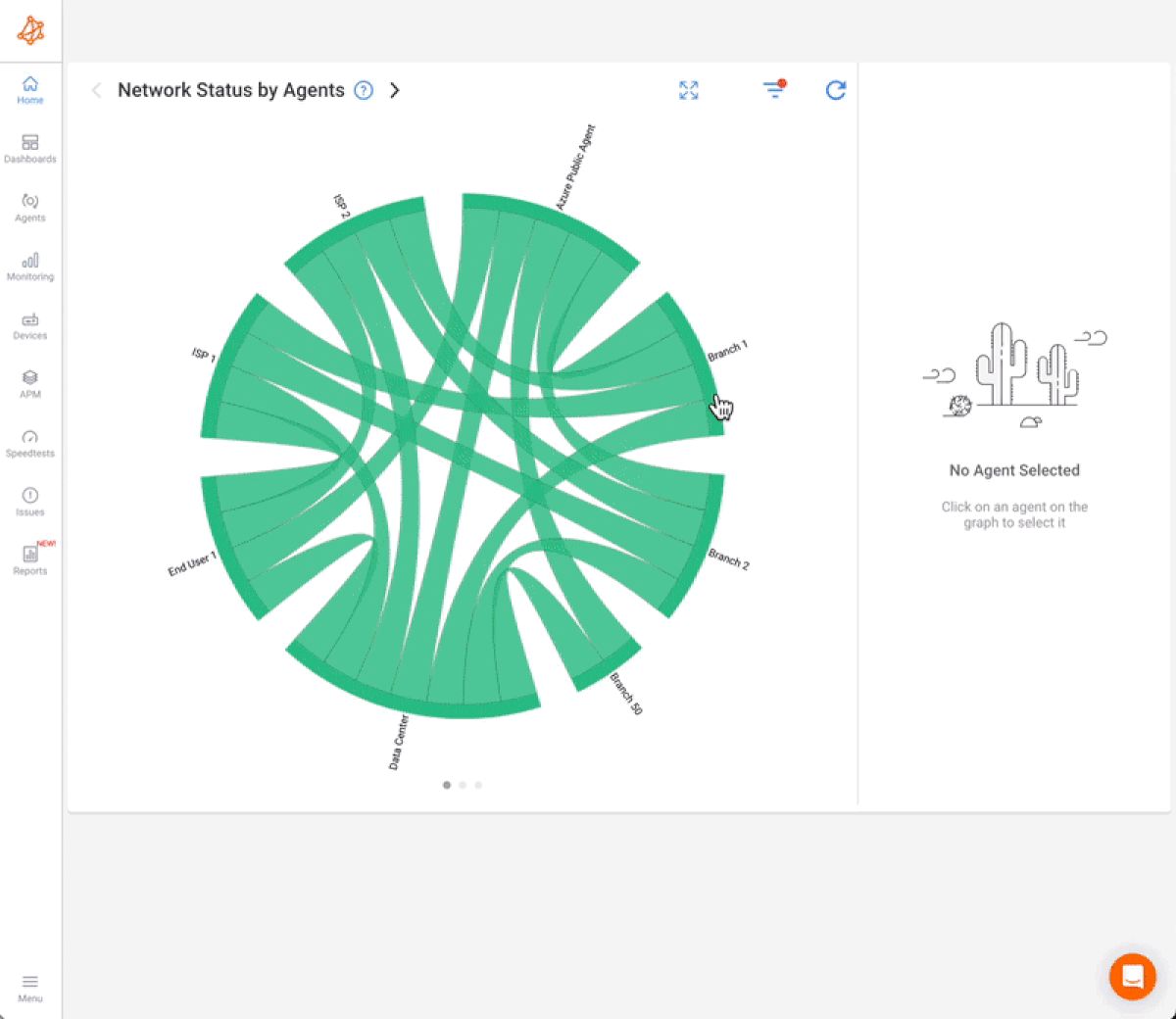
- 14-day free trial of all premium features
- Deploy in just 10 minutes
- Monitor performance in all key network locations
- Measure real-time network metrics
- Identify and troubleshoot live network problems

Effective network and packet burst monitoring using a tool like Obkio relies on deploying Obkio’s Monitoring Agents across various network segments. By installing agents at strategic points, such as branch offices, data centers, and cloud services, you can track traffic and packet bursts in real-time from multiple vantage points.
Obkio’s agents exchange synthetic traffic with each other to gather data on network performance, including packet bursts. Monitoring from multiple locations helps isolate the areas most affected by bursts and provides insights into whether the issue is localized (like in a particular branch) or more widespread (such as affecting cloud services). This level of deployment is essential for diagnosing the specific network segments where packet bursts occur most frequently.

Packet bursts are identified not only by their frequency but also by their intensity. By continuously collecting packet loss data, you can observe the patterns of these bursts over time to determine if they are random or follow specific trends. For example, short bursts may be expected during peak usage, but sustained, intense bursts could indicate network congestion or misconfigured devices.
Obkio’s tool collects and analyzes burst metrics over time, enabling you to distinguish between minor, occasional spikes and more severe, recurring issues that may require intervention.
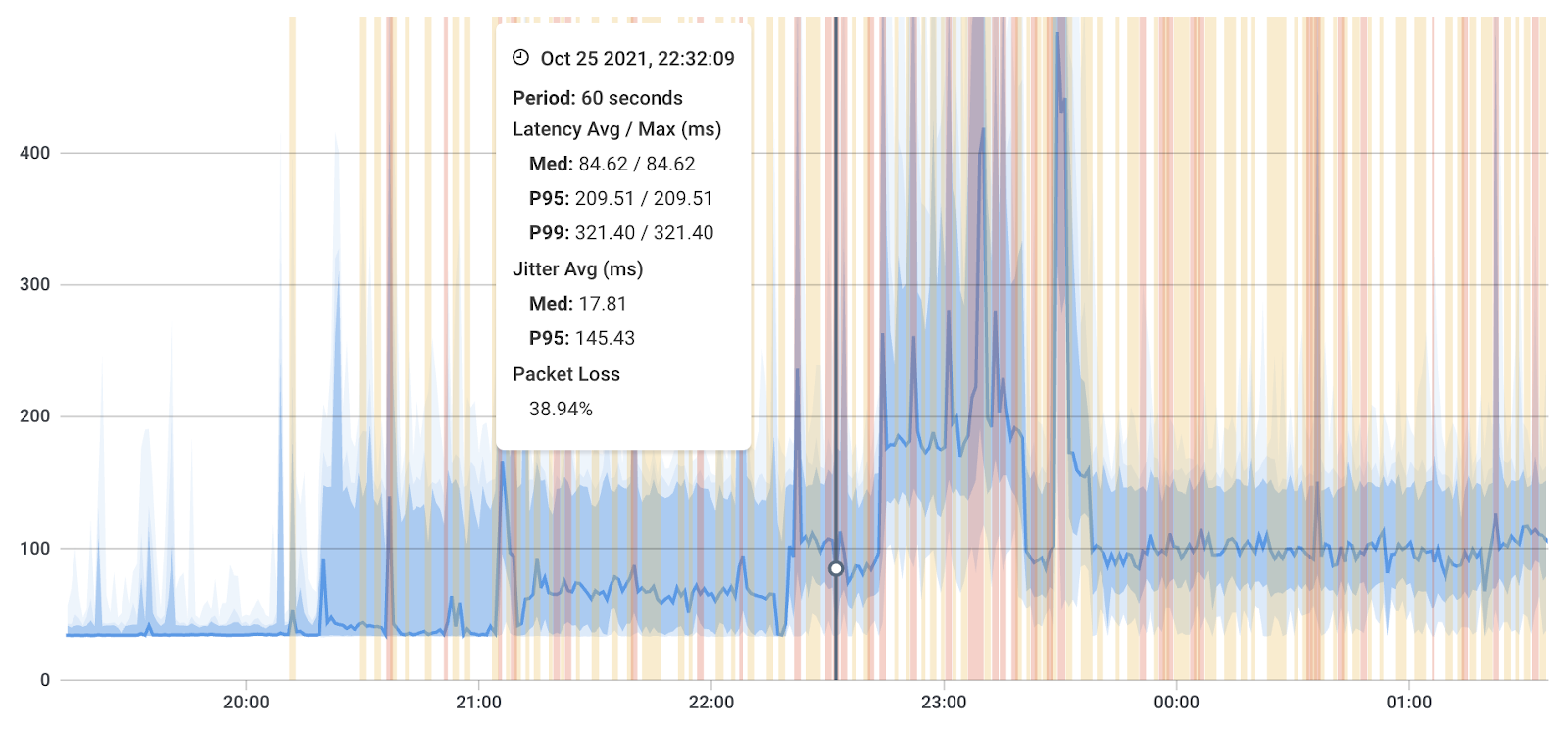
With your agents deployed and data collection underway, using a real-time performance dashboard allows you to visualize packet bursts and their impact. Obkio’s dashboard presents packet burst metrics and highlights traffic spikes and other symptoms that may be the result of packet bursts, such as increased latency, jitter, or reduced throughput.
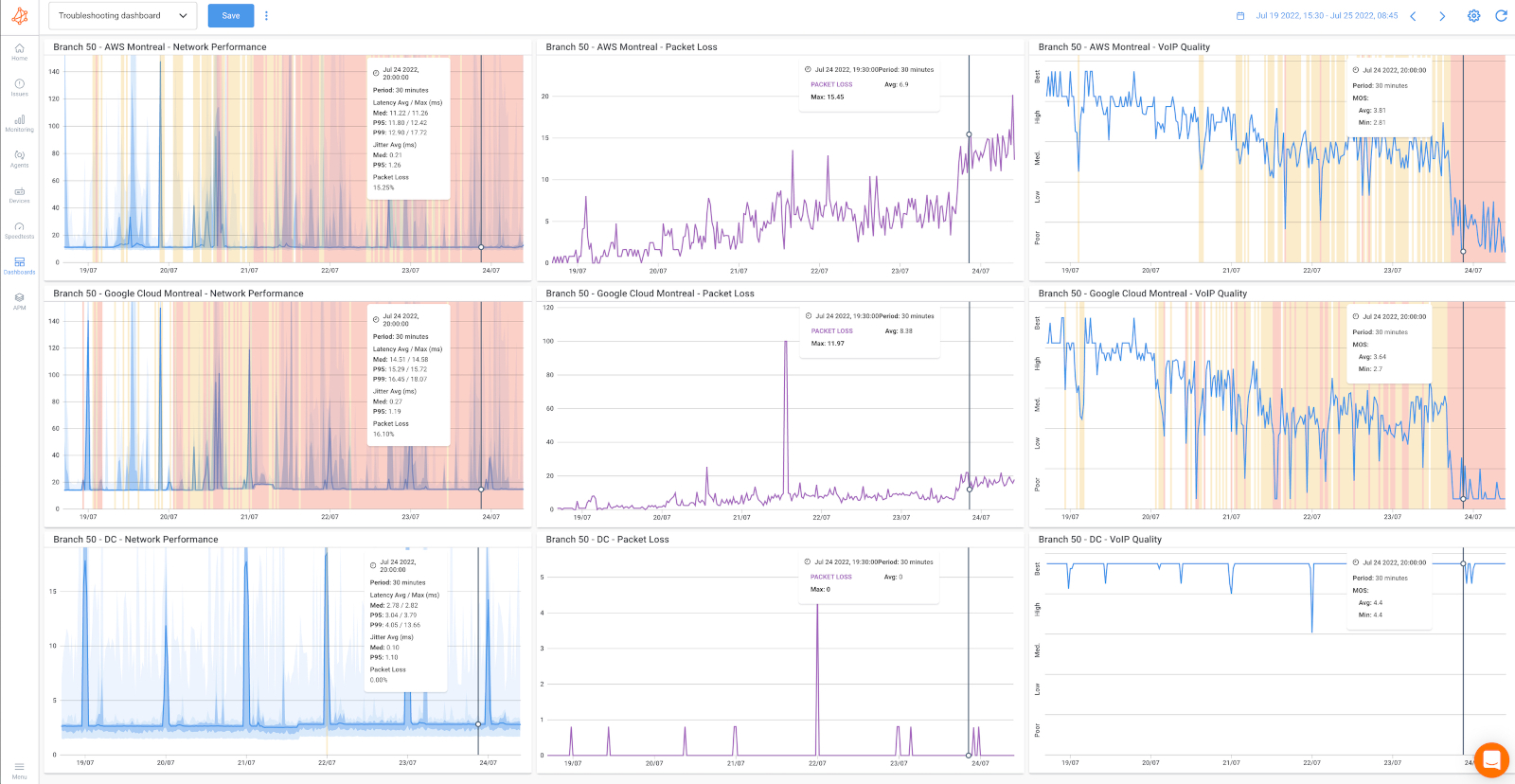
By continuously monitoring this dashboard, you can observe how and when bursts occur, identify any cyclical patterns, and determine if certain network destinations or applications are repeatedly affected by bursts. This insight is critical for understanding the overall impact of bursts and taking an appropriate response.

In Obkio's app, a packet burst would appear as a sharp peak in the congestion graph, highlighting the correlation between increased traffic and its impact on network performance. By monitoring this graph, you can quickly identify and address packet bursts before they disrupt your network.
Setting up custom alerts is essential for addressing packet bursts in real-time. Obkio’s NPM tool allows you to create alerts based on historical data patterns, notifying you whenever packet loss levels deviate from the norm. Custom alerts help ensure that you’re promptly informed about sudden, unexpected bursts, allowing you to investigate and resolve the issue before users experience significant performance degradation.
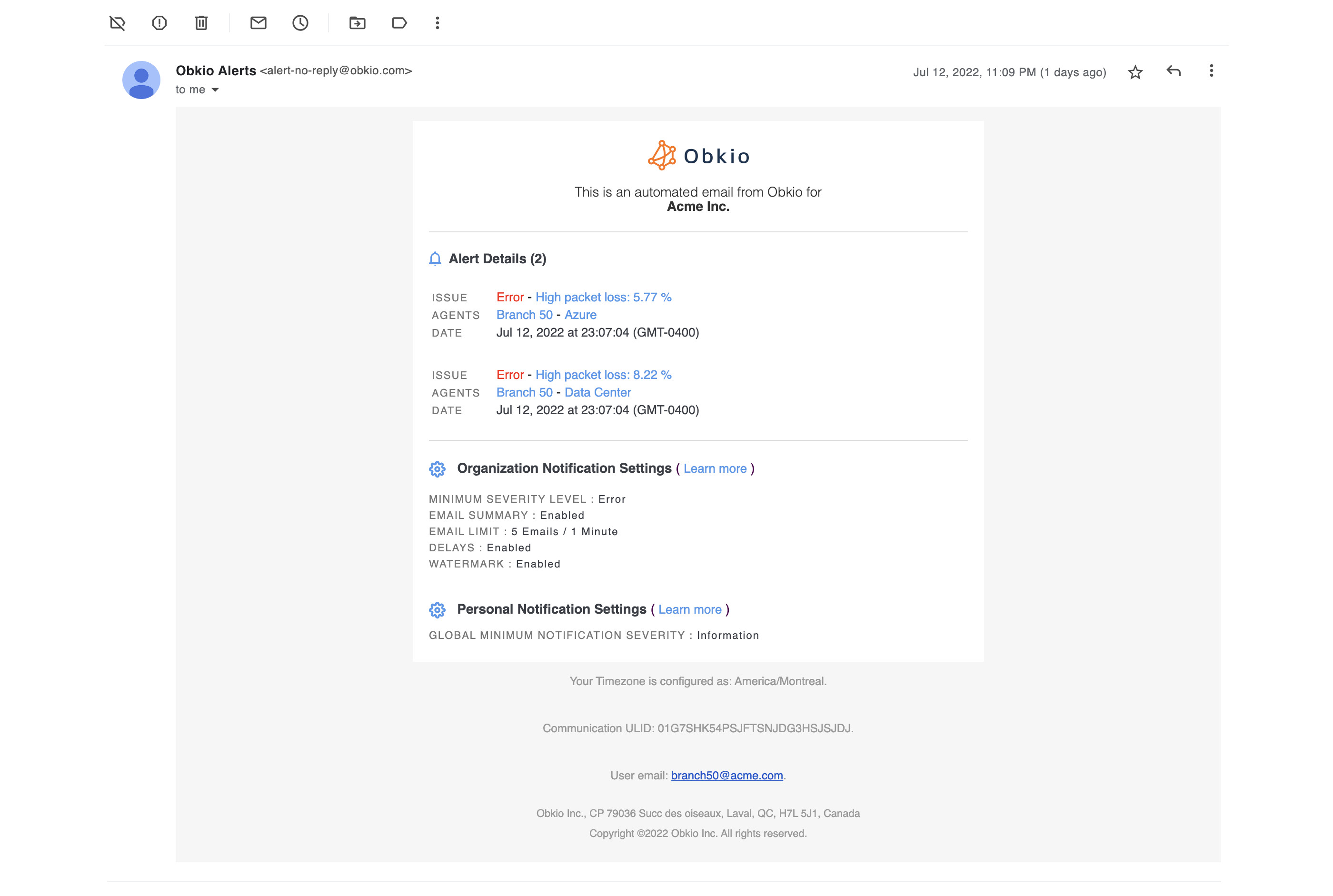
Identifying packet bursts is only the first step, effective troubleshooting requires detailed insights to resolve the root cause. Here’s how Obkio’s network performance monitoring capabilities guide you through comprehensive packet burst troubleshooting:
- Pinpoint Packet Bursts in Your Network: First, verify that packet bursts are indeed occurring within your network. Using Obkio’s network monitoring tool, you can analyze traffic in real-time across key locations, quickly identifying where bursts are happening.
- Examine Network Devices for Signs of Congestion: Routers, switches, and firewalls are common points of failure during packet bursts. Measure metrics like CPU and memory usage on these devices to see if they are overwhelmed. Obkio can alert you to congestion signs like these, which often cause or exacerbate packet bursts.
- Investigate High Bandwidth or CPU Usage: If Obkio detects spikes in CPU or bandwidth usage on network devices, it could indicate that resources are strained, leading to packet bursts. In such cases, consider upgrading device capacity, optimizing configurations, or even reducing traffic through network adjustments.
- Identify and Address Network Congestion: Network congestion can trigger packet bursts, overwhelming devices and links in high-demand situations. With Obkio’s monitoring, you can detect these congestion points and take targeted actions, such as increasing network capacity or optimizing traffic flow.
- Inspect Hardware and Cabling for Faults: Physical issues like damaged cables or malfunctioning network cards can cause irregular packet loss and bursts. Ensure all connections and devices are in proper working order to rule out hardware as a source of the problem.
- Update Firmware and Drivers: Outdated firmware or network drivers can contribute to packet bursts by failing to handle high traffic loads effectively. Updating all network software ensures your devices are operating at optimal performance and compatibility.
- Check Packet Bursts from Your ISP’s Side: If no internal issues are found, the packet bursts may originate from your Internet Service Provider. Use Obkio’s data to gather evidence of external packet bursts, then contact your ISP with this information to escalate the issue efficiently.
Learn how to troubleshoot network issues by identifying where, what, why network problems occur with Network Troubleshooting tools.
Learn more

Packet bursts can happen at various points in a network, typically where data flows between devices, segments, or layers of the network infrastructure. The location of these bursts often determines the scale and nature of their impact on network performance.
Let’s explore the most common network points where packet bursts can occur and the implications of these surges.
The network edge, where data enters or exits, is one of the primary points where packet bursts occur. Routers and gateways handle incoming and outgoing data from external sources, such as cloud applications or streaming services. When multiple users access large downloads, software updates, or high-definition streaming content simultaneously, routers can become overloaded with packets, leading to bursts.
This is especially prevalent in business environments where users frequently download large files or use cloud-based services, causing data surges that exceed the device’s processing capacity.
In organizations using Microsoft Teams or Google Meet, video conferencing generates high volumes of continuous data. When several employees join or leave a call at once, the router may experience a temporary burst, causing network slowdowns or disconnections.
Network Switches, which manage data transmission within a local network, are another common source of packet bursts. In environments where multiple devices (like computers, printers, or servers) transmit data simultaneously, the switch might receive large volumes of packets in quick succession.
This concentrated traffic can overwhelm the switch, leading to congestion and packet bursts within the LAN. Network administrators often encounter these bursts in office setups, where numerous devices share resources and transfer data across the network at once.
Firewalls, which inspect and control traffic flow, can also be a bottleneck for packet bursts. Firewalls process packets to ensure security compliance before allowing data to pass through. When a high-demand application, such as video streaming or a data backup service, initiates a large data transfer, the firewall must process packets rapidly.
If the volume of packets exceeds the firewall’s processing capacity, bursts can occur, potentially causing the firewall to drop packets or delay traffic.
Application servers that send data in bulk, like those handling large file transfers, streaming, or backups, frequently cause packet bursts. These servers may queue up data and release it in a concentrated flow, creating a burst that flows through the network.
Data-heavy applications like video streaming or backup services can generate significant traffic, which can overwhelm not just the server but also the devices handling downstream network traffic.
Many network devices, including routers and switches, use buffering to temporarily store packets before forwarding them. If the buffer fills up quickly, it will hold the packets until capacity frees up, then release them all at once, creating a burst.
While buffering helps maintain packet flow during minor congestion, it can exacerbate bursts if devices continuously struggle to process the backlog, leading to cascading delays throughout the network.

So, you’ve discovered packet bursts messing with your network performance like a toddler with a drum set. One second everything’s calm, and then BAM! A flood of packets overwhelms your gear, like rush hour traffic piling into a one-lane tunnel. But don’t sweat it. Here’s how to smooth out that chaos and get your network zen again.
First things first: packet bursts usually aren’t evil on purpose. They often show up when apps (especially real-time ones like VoIP or video) send lots of data at once, or when queuing and buffering gets wonky on your network devices. So, start by:
- Checking what apps or services are generating traffic spikes.
- Looking at your firewalls, routers, and switches—are they queuing things efficiently, or just dumping everything all at once?
Traffic shaping is like hiring a traffic cop for your network. It controls how data flows so things don’t all stampede at once. Tools like QoS (Quality of Service) can help you:
- Prioritize critical traffic (like Zoom calls) over non-urgent stuff (like someone’s cat videos).
- Limit the rate of bursty applications so they don’t clog the pipes.
A big buffer sounds nice—like a fluffy pillow—but it can actually make things worse by holding onto packets too long and then releasing them in a burst. This is called bufferbloat, and it’s a silent killer of smooth performance.
✔️ Fix: Tune your buffer sizes and look into Active Queue Management (AQM) methods like CoDel or FQ-CoDel. These help your router release packets in a steady flow instead of a cannon blast.
Don’t let all traffic compete for the same lane. Break your network into VLANs or separate subnets so high-traffic apps don’t interfere with everything else. It’s like giving noisy teenagers their own room—peace restored.
Let’s be real—you can’t fix what you can’t see. Use real-time network monitoring to:
- Detect where and when bursts happen
- Identify which devices or apps are the culprits
- Visualize burst patterns and analyze trends over time
Bonus points if your tool gives you historical data and alerting so you can fix problems before your users start yelling.
Packet bursts can have a significant impact on network performance, user experience, and ultimately business productivity, especially in environments that depend on reliable network connectivity.
As we mentioned earlier, packet bursts can affect network performance as a whole and impact the measurements of different network metrics related to the overall performance and data delivery in a network.
- Latency: Packet bursts often result in a sudden spike in latency. For example, when a burst overwhelms network devices, packets must queue before they’re processed. This queuing delay adds to latency, causing noticeable lags in time-sensitive applications like video calls or cloud-based software.
- Jitter: Variability in packet arrival times, known as jitter, increases significantly during bursts. This is problematic for real-time applications, where packets need to arrive in sequence at consistent intervals. For instance, in video conferencing tools excessive jitter can cause screen freezes, audio stuttering, or distorted visuals.
- Packet Loss: When devices are overloaded by packet bursts, they may drop packets to free up space, leading to data loss. This is especially disruptive in ERP systems, where incomplete or delayed data can affect decision-making and order processing.
These issues often cascade, impacting each other and degrading the overall network performance. A spike in latency, for example, can trigger jitter, while excessive jitter may cause additional packet loss as packets are processed out of order.
Learn how to measure network performance with key network metrics like throughput, latency, packet loss, jitter, packet reordering and more!
Learn more

Real-time collaboration platforms, such as Microsoft Teams, Zoom, and Google Meet, are highly sensitive to network disruptions caused by packet bursts. When a packet burst occurs during a video call, users might experience lag, loss of audio, or dropped connections, which interrupts communication flow. In a business setting, such interruptions can have direct consequences: a video meeting between a sales team and a client may suffer, affecting client relations, while internal meetings may be less productive, with attendees unable to communicate effectively.
Metrics for acceptable performance in these applications typically require:
- Latency below 150ms
- Jitter under 30ms
- Packet loss less than 1%
Packet bursts often exceed these thresholds, leading to a degraded experience that can significantly impact employee productivity and client satisfaction.

Packet bursts are equally disruptive for critical business applications such as ERP and CRM systems, which rely on smooth, consistent data flow. ERP systems, used to manage inventory, sales, and financials, require real-time data exchange across multiple departments. If a packet burst occurs, the ERP system may experience delayed data retrieval, affecting processes like order fulfillment and inventory management.
For example, if a manufacturing ERP system experiences delays due to packet bursts, production schedules can fall behind, leading to longer lead times and potentially missed deadlines. Similarly, packet bursts affecting a CRM system can result in laggy performance, making it difficult for sales or customer service teams to access customer data quickly. This could lead to delayed response times, diminished customer satisfaction, and lost sales opportunities.
From a financial perspective, packet bursts can lead to both direct and indirect costs. Direct costs might include the expense of upgrading network infrastructure to handle bursts, while indirect costs often stem from reduced productivity and lost revenue opportunities. For example, a large organization experiencing frequent packet bursts during peak sales periods may suffer from poor system responsiveness, which can result in delayed order processing and reduced customer satisfaction. The lost productivity, increased support requests, and strained client relations add up to significant costs over time.
Repeated packet bursts that go unaddressed can strain network infrastructure over time. Devices forced to constantly handle bursts are likely to experience reduced lifespan due to increased processing demands, leading to higher maintenance costs and potential downtime for replacements or repairs. This can lead to a cycle of degraded network performance, where bursts become more frequent due to the accumulated strain on infrastructure, further impacting business operations.
Addressing packet bursts effectively requires a proactive approach that includes both regulatory measures and continuous monitoring. Here are some strategies for managing packet bursts and minimizing their impact:
1. Traffic Shaping and Quality of Service (QoS) Policies:
Implementing traffic shaping and QoS policies allows you to prioritize certain types of network traffic over others, ensuring that high-priority applications (like VoIP or video conferencing) receive sufficient bandwidth even during bursts. By managing traffic flow, QoS policies can reduce congestion that might otherwise lead to packet bursts, helping to stabilize network performance.
2. Upgrade Network Infrastructure:
In some cases, the best way to handle packet bursts is by upgrading network infrastructure components. Devices like routers, switches, and firewalls may struggle to manage large amounts of traffic if they lack adequate processing power or memory. Upgrading to higher-capacity network devices or increasing bandwidth on critical links can improve your network’s ability to handle sudden surges in traffic smoothly.
3. Continuous Proactive Network Monitoring with Obkio:
Even with traffic regulation and enhanced infrastructure, packet bursts can still happen. To stay ahead, continuous monitoring with a tool like Obkio is essential. Proactive monitoring allows you to spot and analyze packet bursts as they occur, providing the data needed to troubleshoot quickly and prevent impacts on end-users. Continuous monitoring also lets you identify recurring patterns in traffic spikes, which can inform further improvements to network configuration and capacity planning.

It's time to put an end to those sneaky packet bursts disrupting your network! With the insights and strategies we’ve covered here, you should now be equipped to understand where these packet bursts come from and how to tackle them effectively. From identifying the root causes to implementing proactive measures, you’ve got the knowledge to manage and prevent packet bursts from impacting your network's performance.
With Obkio’s real-time network monitoring, you can stay ahead of packet bursts and ensure a seamless experience for your users. Start monitoring, stay proactive, and enjoy a more stable network environment.

- 14-day free trial of all premium features
- Deploy in just 10 minutes
- Monitor performance in all key network locations
- Measure real-time network metrics
- Identify and troubleshoot live network problems



























 Obkio Blog
Obkio Blog




